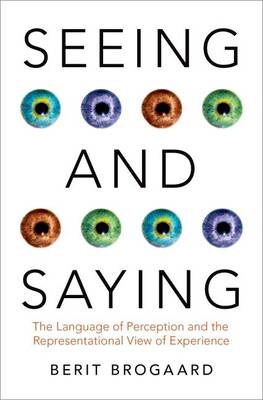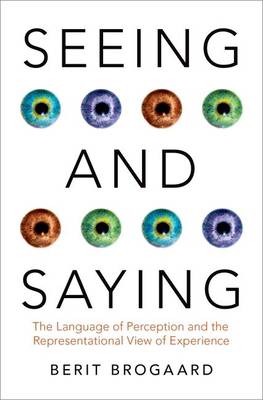
- Retrait gratuit dans votre magasin Club
- 7.000.000 titres dans notre catalogue
- Payer en toute sécurité
- Toujours un magasin près de chez vous
- Retrait gratuit dans votre magasin Club
- 7.000.0000 titres dans notre catalogue
- Payer en toute sécurité
- Toujours un magasin près de chez vous
Seeing and Saying
The Language of Perception and the Representational View of Experience
Berit Brogaard
177,45 €
+ 354 points
Description
Imagine you are sitting at Starbuck glancing at the blue coffee mug in front of you. The mug is blue on the outside, white on the inside. It's large for a mug. And it's nearly full of freshly made coffee. In the envisaged case, you see all those aspects of the scene in front of you, but it remains a question of ferocious debate whether the visual experience that makes up your seeing is a direct "perceptual" relation between you and your environment or a psychology state that has a content that represents the mug. If your experience involves an external "perceptual" relation to an external, mind-independent object, it is unlike familiar mental states such as belief and desire states, which are widely considered psychological states with a representational content that stands between you and the external world. Your belief that the coffee mug in front of you is blue has a content that represents the coffee mug as being blue. Your desire that the coffee in the mug is still hot has a content that represents a state of affairs that may or may not in fact obtain, namely the state of affairs that the coffee in the mug is still hot. In this book, Brit Brogaard defends the view that visual experience is like belief in having a representational content. Her defense differs from most previous defenses of this view in that it begins by looking at the language of ordinary speech. She provides a linguistic analysis of what we say when we say that things look a certain way or that the world appears to us to be a certain way. She then argues that this analysis can be used to argue for the view that visual experience has a representation content that mediates between you and the world when you visually perceive.
Spécifications
Parties prenantes
- Auteur(s) :
- Editeur:
Contenu
- Nombre de pages :
- 216
- Langue:
- Anglais
- Collection :
Caractéristiques
- EAN:
- 9780190495251
- Date de parution :
- 16-07-18
- Format:
- Livre relié
- Format numérique:
- Genaaid
- Dimensions :
- 160 mm x 239 mm
- Poids :
- 430 g

Les avis
Nous publions uniquement les avis qui respectent les conditions requises. Consultez nos conditions pour les avis.






